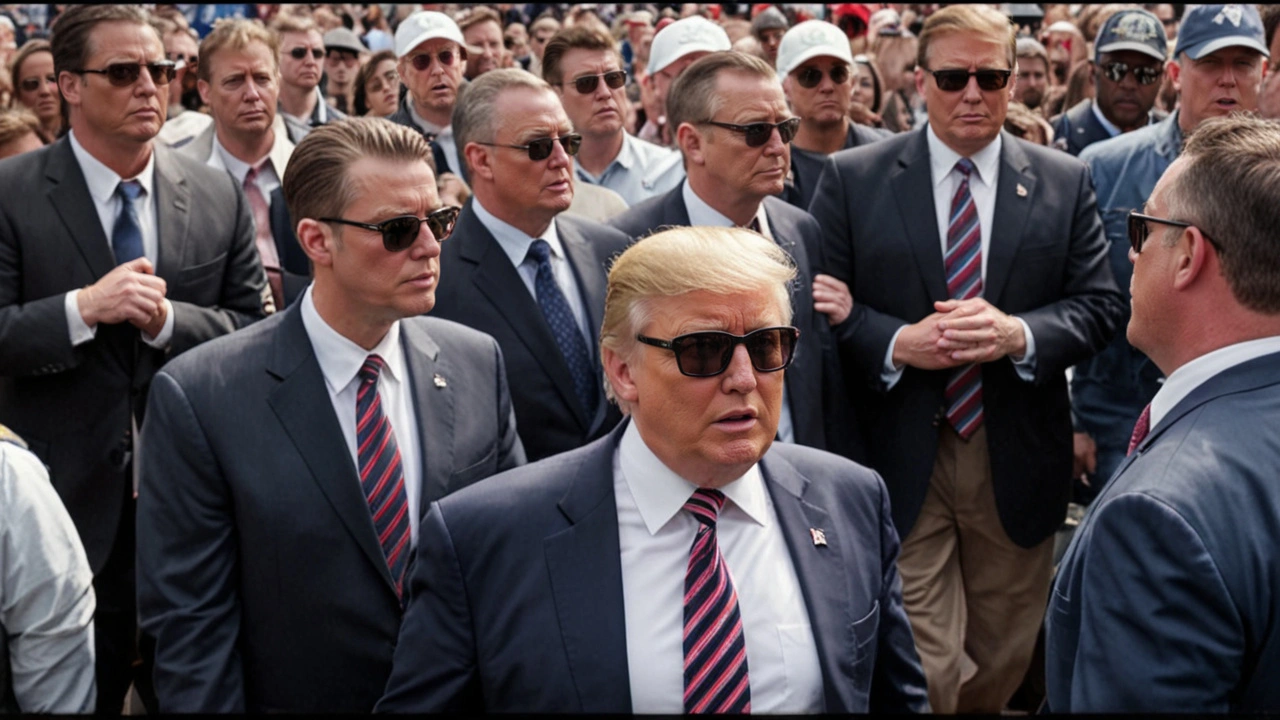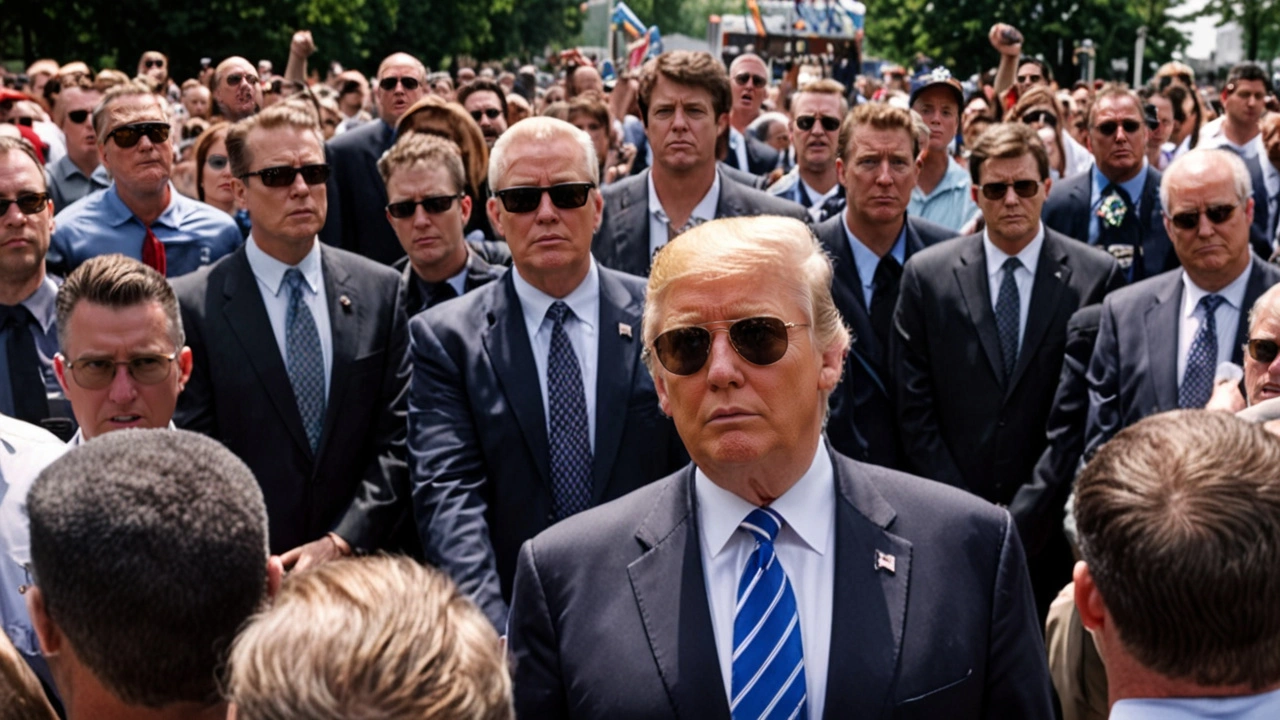Unexpected Turn of Events at Trump’s Pennsylvania Rally
On July 13, 2024, an unsettling incident unfolded at a campaign rally in Butler, Pennsylvania as former President Donald Trump faced a sudden and alarming disruption. While addressing a crowd of enthusiastic supporters, gunshots were heard, prompting immediate and decisive action from his security team.
Trump, a dominant figure in the Republican arena, was in mid-speech when the sound of gunfire startled the attendees. Eyewitnesses describe a moment of sheer panic and confusion as Secret Service agents swiftly moved to protect the former president. For a brief moment, Trump could be seen instinctively reaching for his neck with his right hand. Alarming visuals showed that his face bore visible traces of blood, adding to the urgency of the situation.
The extent of the injury, if it was a direct result of the gunshots or another cause, remains under investigation. However, the priority was to ensure Trump's safety, leading to his prompt evacuation from the stage. The rally, intended as a key moment in Trump's campaign for the Republican presidential nomination, was abruptly halted.
Immediate Reactions and Public Concerns
As news of the incident spread, there was an outpouring of concern from both supporters and political adversaries alike. Social media platforms buzzed with speculation, conspiracy theories, and wishes for Trump's wellbeing. This incident highlighted the ongoing discussions about the safety of public figures and the security measures required at large political gatherings.
Meanwhile, the rally’s attendees were safely escorted from the venue by local authorities, who immediately cordoned off the area for an in-depth investigation. Law enforcement agencies, including the FBI, have been called in to determine the exact nature of the threat and to prevent any potential follow-up incidents. The immediate area was scoured for evidence, and any available CCTV footage was seized to aid in the investigation.
Political and Social Implications
This episode has undoubtedly cast a shadow over the campaign trail. Trump's presence in Butler was part of a broader strategy to galvanize his voter base, and the disruption has ignited debates about the potential risks associated with political rallies in a polarized nation. The conversation has veered towards the need for heightened security protocols, particularly for public figures who attract large crowds.
The incident will likely become a focal point in the discourse around gun control laws in the United States. While Trump's stance on the Second Amendment is well-known, advocating for the right to bear arms, episodes like these underscore the intricate balance between constitutional rights and public safety.
In the aftermath, Trump released a statement thanking his supporters for their concern and reiterating his commitment to his campaign. He praised the quick actions of his security detail and assured his base that he would not be deterred by threats or violence. His resilience is likely to resonate with his supporters, reinforcing his image as a formidable figure in American politics.
Broader Security Concerns
Historically, political figures in the United States have often been targets of violent acts, necessitating stringent security measures. This event serves as a stark reminder of the vulnerabilities that even the most protected individuals can face. Moving forward, there will likely be a thorough review of security protocols at political events, ensuring that such breaches are addressed with even greater vigilance.
Given the scale and the nature of the threat encountered, organizers of future rallies across the political spectrum will be under pressure to demonstrate that they can ensure the safety of both the speakers and the attendees. This includes comprehensive security assessments, the presence of well-trained personnel, and quick response strategies in case of emergencies.

Concluding Thoughts
The rally in Butler, Pennsylvania, was meant to be a significant moment in Donald Trump’s ongoing campaign, yet it will be remembered for an entirely different reason. The swift response from his security team undoubtedly mitigated what could have been a far worse scenario. As Trump continues his quest for the presidency, the lessons gleaned from this incident will shape the way future events are handled. The political landscape in the United States remains volatile, and this situation underscores the ever-present need for vigilance and the complex interplay between democracy, safety, and public discourse.


Hardik Shah
July 16, 2024 AT 01:00This is what happens when you let a clown run for president. Security was clearly asleep at the wheel. Someone should’ve shot him in the other leg just to teach the system a lesson.
manisha karlupia
July 16, 2024 AT 18:49i wonder if this is what peace looks like now... blood on the podium, silence in the crowd, and everyone pretending it's just another day in america. we used to argue about policies. now we argue about whether the bullet was real or not.
vikram singh
July 18, 2024 AT 14:32OH MY GOD. THE DRAMA. THE CHAOS. THE CINEMATIC TENSION! Trump, mid-sentence, clutching his neck like a Shakespearean king betrayed by his own crown-blood glistening under the stage lights like liquid rust! The crowd gasped, the mic dropped, the FBI arrived faster than a Walmart greeter on Black Friday. This isn’t politics anymore-it’s a Netflix docudrama with a live audience and zero script!
balamurugan kcetmca
July 18, 2024 AT 16:02The reality is that this isn’t just about Trump or even about security-it’s about the complete erosion of civil discourse in this country. When rallies turn into crime scenes, when public figures are treated like targets instead of representatives, we’ve crossed a line that can’t be uncrossed. The fear that’s being weaponized now isn’t just from bullets-it’s from the idea that anyone who disagrees with you is an enemy who needs to be silenced, eliminated, or erased. And that’s the real tragedy here, not the blood on the podium.
Arpit Jain
July 20, 2024 AT 01:40They say the bullet missed his head but hit his ego. Honestly if he wasn’t screaming about election fraud for eight years straight maybe someone would’ve noticed the guy with the rifle before he even pulled the trigger. Classic.
Karan Raval
July 20, 2024 AT 12:18i hope he’s okay and i hope everyone is okay and i hope we stop turning every moment into a war zone we are better than this we have to be
divya m.s
July 21, 2024 AT 22:46This was orchestrated. The blood? Fake. The panic? Staged. They needed a martyr for the next election cycle and guess who got the script? The system is rigged and they’re using blood to sell fear like it’s a new flavor of energy drink.
PRATAP SINGH
July 22, 2024 AT 21:46The fact that this is even being discussed as a political event rather than a criminal act speaks volumes about the degradation of public discourse. The man is a pathological liar with the emotional intelligence of a wet sock. His survival is irrelevant; his irrelevance is the point.
Akash Kumar
July 23, 2024 AT 22:39In India, we have long understood that political rallies carry inherent risk. Yet we do not glorify the spectacle of violence. We mourn the loss of dignity. This incident, while tragic, reflects a deeper cultural rot where outrage is currency and trauma is content. The world watches, and we must ask: what kind of democracy celebrates its own near-death?
Shankar V
July 25, 2024 AT 17:20The bullet was a decoy. The real weapon was the media. Watch the footage again-the angle is wrong, the blood pattern doesn’t match the trajectory, and the Secret Service moved in too fast. They knew. They planned it. This was a psyop to justify martial law and the suspension of the 2nd Amendment. The cameras were pre-positioned. The whole thing was a setup. Google ‘Project Blue Beam’ and tell me I’m wrong.
Aashish Goel
July 26, 2024 AT 22:35so… like… did anyone else notice the guy in the red hat in the back who just… stood there? like, not running? not screaming? just… watching? and then he disappeared? weird right? also the mic looked kinda… sticky? maybe it was spit? or blood? idk i’m just saying
leo rotthier
July 27, 2024 AT 13:30This is what happens when you let foreigners run this country. We had a president who actually stood for America and now look-blood on the stage and the world is laughing. We need to build a wall around the whole damn country and never let another outsider near a stage again
Karan Kundra
July 28, 2024 AT 13:52i’m so glad he’s okay but i’m also so sad that this is our reality now. we used to cheer for leaders, now we brace for bullets. let’s not forget to thank the agents who put themselves in harm’s way. they didn’t have to. they chose to. that’s worth remembering
Vinay Vadgama
July 30, 2024 AT 02:00While the incident is deeply regrettable, it is imperative that we maintain composure and uphold the principles of democratic resilience. The strength of a nation is not measured by the absence of violence, but by its collective capacity to respond with dignity, unity, and unwavering commitment to the rule of law.
Pushkar Goswamy
July 30, 2024 AT 08:23They tried to silence him. They thought blood would break him. They didn’t know Trump doesn’t break-he amplifies. The rally was supposed to be a speech. Now it’s a legend. The blood on his shirt? That’s not a wound. That’s a brand. The next rally won’t be in a stadium. It’ll be in a fortress. And the crowd? It’ll be ten times bigger. This isn’t the end of the story. It’s the opening scene.
Abhinav Dang
July 30, 2024 AT 10:25this is why we need trauma-informed campaign infrastructure like yesterday. the mental health of the electorate is being weaponized by design. we’re not just dealing with security gaps-we’re dealing with systemic emotional sabotage. the real threat isn’t the shooter, it’s the algorithm that monetizes panic. we need to rebuild the public square with empathy, not echo chambers
krishna poudel
August 1, 2024 AT 03:53I told you this was coming. I told you he was a walking target. I told you the Secret Service was understaffed and overpaid. I told you the crowd was full of idiots who didn’t even notice the guy with the backpack. I told you. I told you. I told you. And now? Now we get to watch the rerun on every channel. You’re welcome.
Anila Kathi
August 1, 2024 AT 04:56i mean… it’s wild that we’re all talking about this like it’s normal?? like we’ve just accepted that politicians get shot and then we post memes about it?? 🤔 maybe we should all just… sit down and talk for once?? 😔
vasanth kumar
August 1, 2024 AT 09:16in my village in kerala, when someone gets hurt, the whole community gathers. no cameras. no hashtags. just hands. this feels like the opposite. we’ve turned tragedy into a livestream. we need to remember we’re human before we’re viewers
Andalib Ansari
August 2, 2024 AT 00:58What does it mean to be a leader in a society that has normalized violence as entertainment? Is democracy sustainable when its most visible figures are treated as gladiators in a televised arena? The rally was meant to rally. Now it has become a ritual. And we, the audience, are complicit in the performance. We watch. We react. We scroll. We forget. And then it happens again.